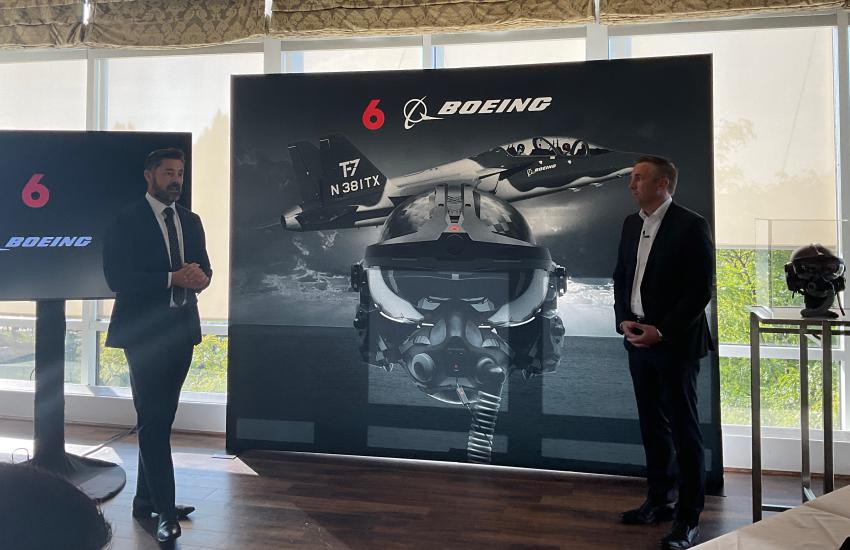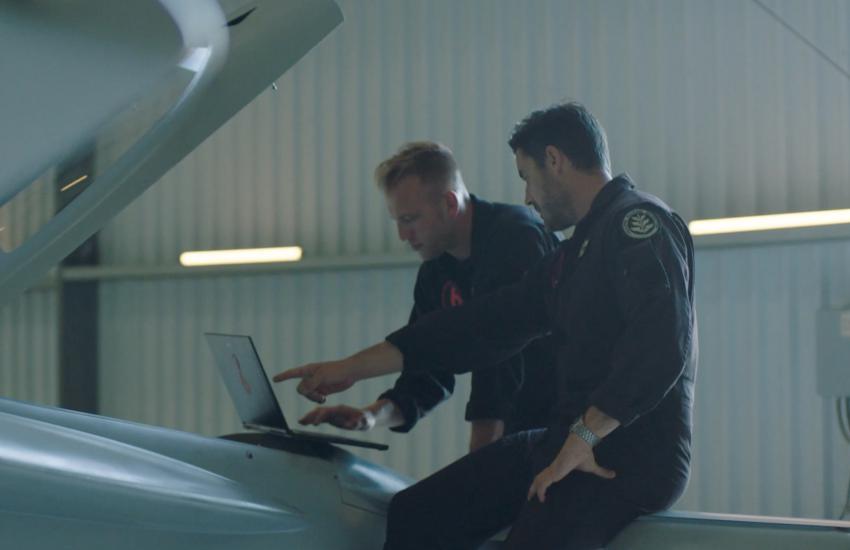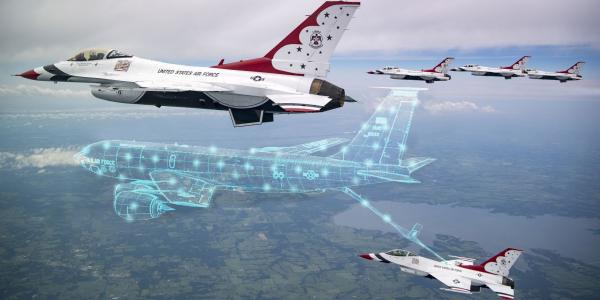Boeing Flies Into Augmented Skies with Red 6
Arlington, Virginia-based Boeing is teaming up with five-year old augmented reality company Red 6, headquartered in Orlando, to bring augmented reality airborne to fighter pilots. The aircraft manufacturer plans to begin integrating Red 6 Airborne Tactical Augmented Reality System (ATARS) hardware on one of its TA-4 aircraft in St. Louis next month, reported Dan Gillian, vice president and general manager of U.S. Government Services at Boeing Global Services. “And we're going to learn how to work together with an eye towards platforms like the T-7 and the F-15EX,” he said.
Boeing is under contract to deliver T-7 training aircraft to the U.S. Air Force that include integrated live virtual constructive (iLVC) elements, Gillian explained. With the Red 6 partnership, Boeing is spending its own independent research and development, or IRAD, dollars to bring in the new technology. “On the A-4 integration front, it is really about the CONOPS [concept of operations] of working together [with Red 6] and how our pilots are experiencing [ATARS] and where we think we can go with the technology,” the Boeing executive noted.
The companies announced the partnership yesterday at an event following the Air and Space Forces Association conference at the Gaylord Resort, Maryland, with Gillian and the Red 6 co-founder and CEO Daniel Robinson presenting the news to reporters and Air Force officials.
“At Boeing Global Services our job is to help our customers use and take care of their products, and increasingly we're doing that with innovative digital solutions,” Gillian stated. “As part of using our products, we have a lot of work with the government, training aircrew how to operate the platform. Training is a huge part what we do to help our customers. Boeing sees the future of training in the iLVC [environment]. It is something we're working with for a number of platforms. It is the way the world is going and the way our products are going to work.”
“iLVC, in my view, is the only way that we are going to solve the future of combat training both from the production of pilots, getting them to the frontline in good order to a high standard and then from a tactical perspective, for the frontline platforms, how do we think about being able to train at scale and creatively at relevance, and how we simulate peer adversaries,” Robinson stated.
Up until Red 6’s solution, however, there was a capability gap in iLVC environments, Gillian explained. Red 6 has been able to render and display an interactive digital environment to fighter pilots up in the skies, while they are flying at top speeds, allowing them to dogfight against digital opponents or practice refueling while actually flying in their aircraft. ATARS also provides digital opponents, such as the fifth generation Chinese J-20 and Russian Su-57, as well as other digital assets to develop and enhance different piloting skills in the skies.
The system allows for more realistic training than traditional training scenarios. It enables fighter pilots to be closer to digital opponents in a dynamic air combat environment, where they can reach several hundred miles per hour and pull a gravitational force of nine (9 Gs) while interacting with the digital assets, according to Red 6.


“That in itself is a technical feat, making AR [augmented reality] work not only outdoors at 1 mile an hour is difficult enough,” Robinson stated. “And up in the sky flying 500 miles an hour going upside down pulling 9 Gs is challenging. We have done this.”
“There's been a challenge with iLVC over the last couple of years,” Gillian continued. “When a target gets close in visual range, how do you make that merge happen in a simulated environment. Dan [Robinson] and our partners at Red 6 have development solutions that are going to help us solve that problem and really unlock the full potential of iLVC. … We are really excited to bring the best team together to solve these problems for the warfighter.”
Last summer, the Air Force awarded Red 6 a $70-million, sole-source, five-year contract for ATARS use in the air by pilots training for initial pilot qualification, dogfighting, refueling and maneuvering. The company started with ATARS integration into T-38 training aircraft through the service’s Air Education and Training Command, beginning with Holloman Air Force Base, New Mexico.
Since then, Red 6 has grown the synthetic air combat training platform into a larger digital ecosystem that includes their Combined Augmented Reality Battlespace Operational Network, or CARBON, and the Augmented Reality Command and Analytic Data Environment, or ARCADE.
I envision a future in the next five to 10 years where the guys and girls on the frontline who are taxing out in airplanes are able to do large force engagements every single day of the week. I can see an entirely synthetic adversary force controlled by artificial intelligence using a combination of iLVC and the system we produced. …. And, dare I say it, what this technology could bring to operations as well.
These systems, in addition to ATARS installed on fighter jets, unite real-world actions with a digital world while airborne. In June, using the CARBON platform, Red 6 successfully flew the first multi-aircraft training flight against multiple digital assets, connecting into an airborne military metaverse, the company reported. The network allowed each pilot to see and interact with the same augmented reality-generated KC-46 Pegasus Tanker and conduct refueling training missions. ARCADE serves as the integrated data environment to leverage real-time flight information.
For Robinson, Red 6’s vision into the future brings even more innovative real-world flying with augmented digital environments. “I envision a future in the next five to 10 years where the guys and girls on the frontline who are taxing out in airplanes are able to do large force engagements every single day of the week,” Robinson said. “I can see an entirely synthetic adversary force controlled by artificial intelligence using a combination of iLVC and the system we produced. …. And, dare I say it, what this technology could bring to operations as well.”
The company, started by Robinson, Glenn Snyder—founder and chief product officer—and Nick Bicanic—founder and chief science officer—grew from a technology by Snyder built to enable a race car driver on a track in the United Kingdom to race against a driver in the United States at the same time. Robinson, who was the first non-U.S. pilot to fly the F-22 Raptor with the U.S. Air Force, had the vision of taking Snyder’s technology airborne. The company also includes board members Gen. Mike Holmes, USAF, (Ret.), former commander of Air Combat Command, and Will Roper, the service’s previous acquisition officer, and has a cadre of test pilots to include airmen that have flown the Air Force’s F-35, F-22, F-18, F-16, and F-15 fighter jets.





Comments